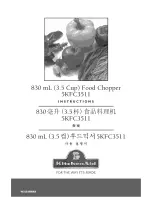
I-6
MANUAL ADDENDUM
Orban
New Multi-Band Features For Version 3.00
High Frequency Coupling Control (Band 3&4 Coupling)
High Frequency Coupling couples a certain percentage of the Band 3 gain control signal
into Bands 4 and 5. This forces Bands 4 and 5 to follow the gain reduction in Band 3 to a
user-adjustable extent. Because Band 3 has a slower release time than Bands 4 and 5,
this results in a more open high end. It also limits the amount of dynamic HF boost that
the processing can produce.
Even with the control at 100%, Bands 4 and 5 are still active and will produce further
gain reduction if this is necessary to prevent distortion. So in this mode they are acting as
a high frequency limiter.
Multi-Band Mix Controls (Band 1-5 Out Mix dB)
All of the equalization described so far occurs
before
the multi-band limiter. The
advantage of this is that the multi-band limiter protects you against overloads or program
material with unusual spectral balance, which might otherwise combine with your
equalization curve to cause unpleasant distortion or coloration. In particular, it protects
the final clipper from being overdriven.
However, the
downside
is that the “automatic equalization” effect of the multi-band
limiter tends to fight equalization settings that you made with the various equalizer
controls, reducing their effect. We have therefore provided a mix control with a ±3dB
range at the
output
of each limiter in the five-band limiter.
These act as fixed equalizer controls because no gain reduction occurs after them. They
determine the overall target spectral balance of the processing when the multi-band
limiter exhibits substantial amounts of gain reduction. In popular music formats this is
almost always the case.
Please note that these controls are
very risky
. The thresholds of OPTIMOD-FM's 5-band
limiter and multi-band clippers were tuned at great length to ensure that under virtually
no circumstances would program material come along to cause unpleasant clipping
distortion in the following clippers. By adjusting the multi-band mix controls, you upset
this carefully tuned relationship. Therefore, program material can come along that causes
unexpected (and sometimes very nasty-sounding) distortion because the final clippers are
being overdriven. This will occur if the program material in question has a significant
part of its energy concentrated in a frequency band that is being boosted.
In general, it is safe to turn a given output mix control
down
(in the 0 to –3dB range)
without danger of introducing distortion. However, you will lose loudness. If you turn an
output mix control
up
(+0.5 to +3dB range), you should listen at great length to a wide
variety of program material to make sure that nothing falls apart due to excessive













































